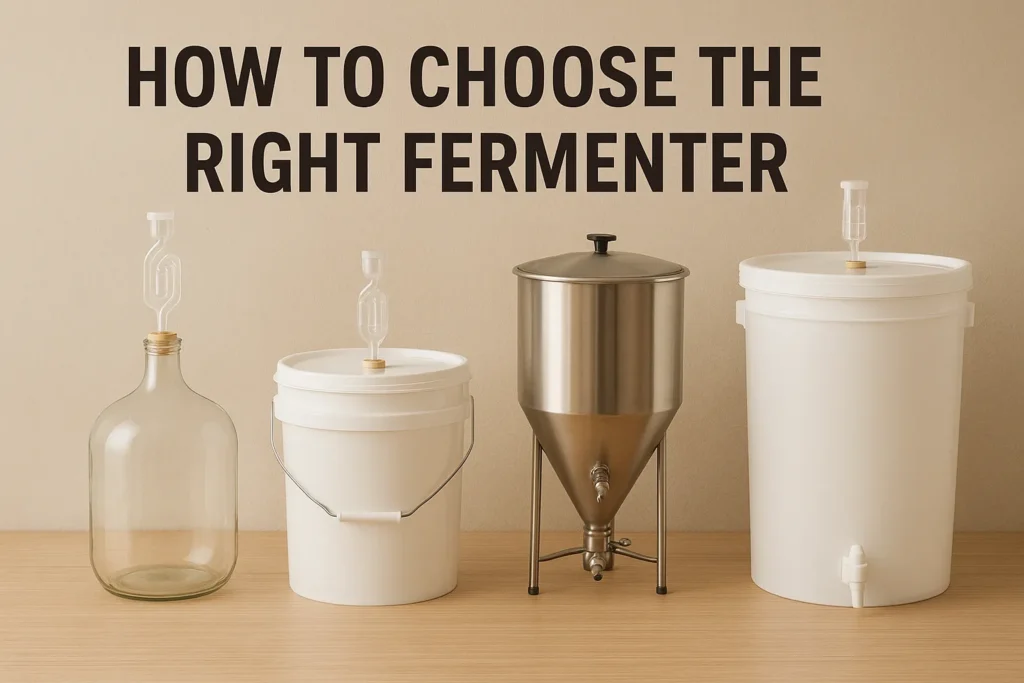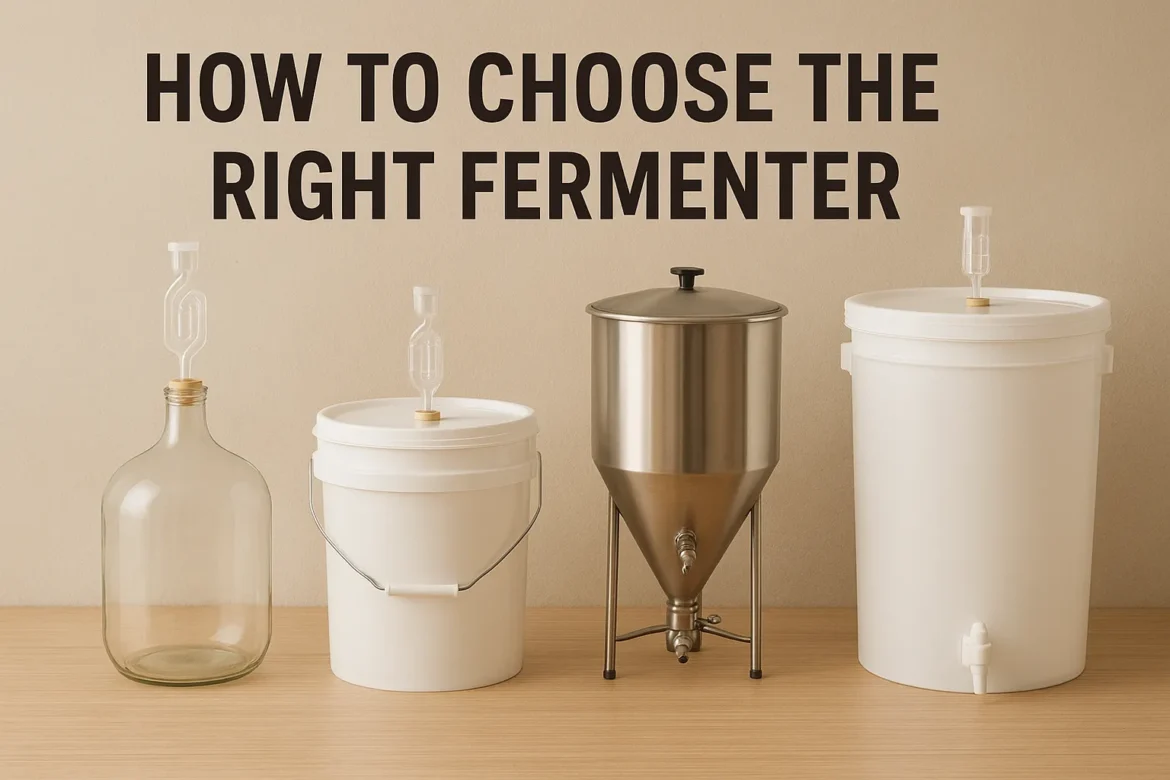Choosing the right fermenter is crucial for any homebrewer. This comprehensive guide explores fermenter types, sizes, features, pros and cons, and pro tips—so you can select the perfect fermenter for your space, brewing goals, and budget.

As a homebrewer—and now the guy my friends call when they’re stuck with clogged airlocks or lost yeast—I’ve come to realize that picking the right fermenter is one of the most important, and most misunderstood, decisions you’ll make. The fermenter isn’t just a vessel—it shapes everything from your beer’s flavor to your cleaning routine, to how proud (or frustrated) you’ll feel on bottling day.
If you’re tired of guessing what will work or getting lost in a maze of options (conical? bucket? stainless? glass?), you’re in the right place. This guide will walk you through how to choose the right fermenter for your needs, grounded in experience, current tech, and the realities of different brewing ambitions. Expect real-world tables, comparison charts, friendly cartoons, and even a tap into some pro secrets—all so you can focus on brewing the best beer possible.
Brewing Science 101: What Exactly Is a Fermenter?
A fermenter is the closed vessel where your wort transforms into beer, cider, mead, or wine—thanks to yeast eating sugar and creating alcohol, CO2, and tons of flavor. The fermenter needs to:
- Be airtight (except for letting CO2 escape).
- Prevent contamination.
- Be easy to clean and sanitize.
- Be the right size relative to your batch.
Why Fermenter Choice Matters More Than You Think
If your fermenter is too small, you’ll lose beer to spills. Too big, and you risk oxidation or stalling your yeast. Some vessels make cleaning a chore; others make oxygen exposure a non-issue. Some are budget-friendly for newbies; others are investments for serious brewers.
| Problem | Wrong Fermenter Causes |
|---|---|
| Unexpected off-flavors | Poor seals, hard-to-clean corners |
| Stuck fermentation | Wrong temperature control, too much oxygen |
| Waste or spills | Not enough headspace |
| More work | Lots of transfers between vessels |
The Three Classic Types of Homebrew Fermenters (and What Sets Them Apart)
1. Plastic Bucket Fermenters
Plastic buckets (usually food-grade HDPE or PET) are the trusty Ford pickup of the brewing world: functional, affordable, and easy to use. Most starter kits include a 6- or 7-gallon version.
Pros:
- Lightweight and cheap
- Easy to clean and transfer (big opening)
- Graduated volume marks
Cons:
- Scratches over time, risking infection
- Not ideal for long-term use
- Often lets a little oxygen in
When it’s best:
Great for beginners, small budgets, or anyone who wants equipment that won’t break your heart if it gets dropped.
2. Glass Carboy Fermenters
Glass carboys lend homebrew an old-world chemistry lab vibe—and with good reason! Glass is inert, scratch-proof, and easy to sanitize.
Pros:
- No oxygen permeability
- No risk of plastic flavors
- You can watch fermentation (fun and educational!)
Cons:
- Very heavy, breakable
- Narrow neck makes cleaning tough
- No built-in spigot
When it’s best:
Perfect for long aging, wines, meads, and anyone who wants crystal clarity or to show off active fermentation.
3. Stainless Steel and Conical Fermenters
Stainless steel fermenters (both bucket and conical) are the “dream car” for many brewers—unkillable, airtight, often with pro-style valve, racking, and temperature control options.
Pros:
- Easy to sanitize, will last forever
- Can be fitted with sampling ports, thermowells
- Pressure-rated options for carbonation
- Conical bottom lets you dump yeast, trub easily
Cons:
- Expensive up front
- Heavy, need careful cleaning
- Pro features take learning to master
- Require more space
When it’s best:
For advanced brewers, anyone scaling up, and those looking for zero-compromise gear to last a lifetime.
Comparing Fermenter Types at a Glance
| Feature | Plastic Bucket | Glass Carboy | Stainless Steel/Conical |
|---|---|---|---|
| Price Range | $-$$ | $$ | $$$-$$$$ |
| Durability | Medium | Low | Very high |
| Oxygen Permeability | Some | None | None |
| Cleaning Ease | High | Tricky | High |
| Visibility | Opaque | Clear | Usually opaque |
| Accessories | Limited | Limited | Many |
| Lifespan | 1-5 years | 10+ years | Decades |
| Batch Size Options | 1–8 gal | 1–6.5 gal | 2.5–30+ gal |
Specialty Fermenters: Modern Innovations for Discerning Brewers
- PET Conicals
Like the Fermzilla All-Rounder, these blend affordability, lightweight design, and a conical shape that lets you capture healthy yeast or dump trub easily. PET means it’s clear but tougher—and many are pressure capable for advanced techniques. - Nano & Small Batch Fermenters
A dream for apartment brewers or experimentalists: half-gallon to 3-gallon fermenters designed for small batch brewing. - Integrated Temperature Control Fermenters
Some stainless steel models incorporate built-in cooling coils or jackets. If maintaining exact temps is crucial (think lagers or pro-level ales), consider this upgrade.
Batch Size: How to Match Size with Your Brewing Ambition
| Batch Size (Gal) | Ideal Fermenter Size | Best For |
|---|---|---|
| 1–1.5 | 2-gal | Test recipes / small kitchen |
| 3 | 4-gal | Quickly scaling up |
| 5 (standard) | 6–7 gal | Most homebrew recipes |
| 10 | 12–14 gal | Group / club brews |
Rule: Always leave at least 15-20% headspace above your wort for krausen, the yeast foam that forms early in fermentation.
Feature Spotlight: The Real-World Fermenter Checklist
Here’s exactly what I look for after years of trial and error:
- Airtight Sealing:
Make sure the lid/gasket/airlock fits well. CO2 must exit, but nothing else should get in. - Ease of Cleaning:
Wide mouths and stainless interiors make it easier to deep-clean. - Spigot/Valve:
A built-in spigot prevents siphon juggling on bottling day. - Graduated Markings:
Volume markings mean no math or last-minute measuring disasters. - Material Matters:
Pick glass or steel for zero oxygen permeability, plastic or PET for mobility and price. - Headspace:
Too much = risk of oxidation, too little = messy blowouts. - Temperature Control:
Look for optional cooling jackets or a form factor that fits a standard fridge.
Pros & Cons Scorecard (Rate Each Fermenter Type for the Top Features)
text| Feature | Plastic Bucket | Glass Carboy | Stainless Steel Conical |
|------------------------|:--------------:|:------------:|:----------------------:|
| Sanitation | 7 | 8 | 10 |
| Cost | 9 | 7 | 3 |
| Weight | 9 | 4 | 3 |
| Ease of Use | 9 | 6 | 7 |
| Customization | 4 | 4 | 10 |
| Oxygen Resistance | 6 | 10 | 10 |
| Durability | 5 | 4 | 10 |
How to Choose the Right Fermenter for Your Style, Batch, and Space
- Budget-Driven? Go for food-grade plastic.
- Love Lagers or Want Ultimate Control? Stainless conical with temp control wins.
- Small Batches or Experiments? PET or glass in 1-3 gal sizes is smart.
- Plan to Age or Condition for Months? Glass or stainless is essential (plastic risks O2 ingress).
- Want to Try Pressure Fermentation? Look for PET or stainless rated for pressure.
Top-Rated Fermenters for 2025 by Scenario
| Scenario | Best Fermenter | Model/Type | Why It Wins |
|---|---|---|---|
| Budget Beginner | Plastic Bucket | Anvil 7.5 gal Bucket | Cheap, reliable, easy use |
| Long Aging/Clarity | Glass Carboy | 5 gal Classic Carboy | Crystal clear, O2 proof |
| Size-Restricted Spot | PET 3-gal Fermonster | Wide Mouth Fermenter | Maneuverable, light |
| All-in-One Convenience | Conical PET (Fermzilla/All-Rounder) | Fermzilla 55L | Dump yeast/trub, dry hop |
| Serious Home Pro | Stainless Conical (SS Brewtech) | 7 gal SS Brewtech Chronical | Pro features, forever gear |
| Farmhouse/Experimental | Mason Jar or Small Carboy | 1 gal (glass) | Micro batches, infusions |
FAQ: Common Fermenter Questions
Can I use a fermenter that’s much larger than the batch?
Within limits, yes. Too much headspace can increase oxidation risk for long conditioning, but for primary fermentation, as long as the vessel is at least 20-30% full, CO2 will blanket the beer and protect it. For smaller batches, match fermenter volume closely to batch size for best results.
Are conicals worth the money?
If you want professional-level yeast management, closed transfers, and built-in sampling/valving, yes. They’re the best investment for advanced brewers planning to brew often—or lager at a high level.
Which fermenter is easiest to clean?
Plastic buckets and modern stainless steel units with wide openings are easiest. Glass carboys with a narrow neck are notorious for being difficult, though bottle brushes help.
Do I really need temperature control?
For most ales, stable room temp is fine. For lagers or advanced styles, a fridged fermenter with a temp controller, or jacketed steel unit, unlocks consistency and complexity.
Looking to explore more about fermentation management and advanced brewing equipment? Check out BrewMyBeer’s expert fermentation guides for hands-on tips, gear reviews, and troubleshooting support.
Final Thoughts: Your Perfect Fermenter Awaits
Choosing the right fermenter isn’t about status or blindly copying “what everyone uses.” It’s about honest assessment—where you brew, what you brew, how often, and your appetite for hands-on tinkering. Plastic buckets are not just for beginners; glass is not just a risk for butterfingers; stainless is not just an Instagram flex. Match vessel to goals, treat it with care, and it will reward you with batch after batch of delicious, fuss-free beer.
Brew smarter, not just trendier. A good fermenter means fewer distractions, more focus on the journey from grain to glass, and (best of all) consistently better beer.
About the Author
Ryan Brewtech is a homebrew educator, equipment consultant, and fermentation geek whose kitchen has seen everything from wild fermented saisons to five-minute meads. He helps brewers of all levels match tools to goals, cut through the equipment hype, and troubleshoot for peak results. When he’s not brewing or bottling, he shares advanced fermenter hacks and new equipment reviews with the BrewMyBeer online community. Reach him at [email protected] or check out his latest guides on brewmybeer.online.

